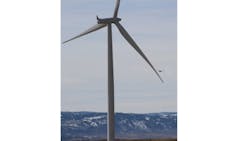Boulder Imaging Develops System to Protect Endangered Birds
Boulder Imaging (Louisville, CO, USA) has developed an AI-assisted vision system that helps protect birds from wind farm turbine blades. The system, known as IdentiFlight, combines cameras and AI-algorithms to detect, track, and predict flight paths, and if necessary, temporarily curtail wind turbine activity so that birds in the vicinity of a wind farm may safely fly through dangerous areas.
Wind energy facilities usually consist of several large windmill-like structures that use wind to power huge turbine fan blades in order to generate electricity. Wind turbines currently account for a small percentage of the total amount of energy generated—wind turbines accounted for a little over 10% of the total energy generated in the U.S. in 2022, according to the U.S. Energy Information Administration—but wind-generated energy is a growing market segment within the clean energy sector. In fact, the U.S. Energy Information Administration has projected that wind power generation will grow 11%, from 430 billion kWh in 2023 to 476 billion kWh in 2025.
Unfortunately, wind turbines can be dangerous to birds. For example, a 2020 report by the National Audubon Society (New York City, NY, USA) estimated that 140,000-679,000 bird deaths occur per year due to birds colliding with turbine blades.
While most of those are smaller birds, such as songbirds, the second most impacted bird population is raptors, which includes endangered species such as eagles, kites, and condors.
For example, in 2014, Duke Energy (Charlotte, NC, USA) found itself in violation of the U.S. Migratory Bird Treaty Act after a number of eagles were killed in collisions with wind turbines at Duke’s Top of the World Wind Farm (named because it is located near a high ridge where golden eagles nest) in Glenrock, Wy. As part of a settlement agreement with the U.S. government, Duke started working with Boulder Imaging, which beta tested IdentiFlight at that facility.
See Related Content: The Nature Conservancy Brings Cameras, AI, to Invasive Species Prevention
How the Machine Vision and AI Solution Works
An IdentiFlight system consists of one or more stations networked together and connected to a control server on a wind farm.
Each IdentiFlight station is a self-contained unit, consisting of cameras and a computer with AI software, that can detect and identify birds flying up to 1.3 km away, with 99 % accuracy, according to Boulder Imaging Director of Sales Joey Nesbitt.
“Our company developed the hardware, software, and neural networks,” Nesbitt says. “Our technology is also patented. We do not build the cameras themselves but rely on top-tier camera and lens manufacturers to source our components.”
Each station consists of eight fixed position, wide FOV industrial cameras and two movable high-resolution stereoscopic cameras mounted on a “head” atop a six-meter tall (or taller, depending on terrain) tower. The cameras are wired to a computer, located in the control cabinet at the base of the unit.
Typically, several IdentiFlight stations are deployed around a wind farm and each station can usually cover more than one turbine unit. All of the stations are networked together, either wirelessly or via fiber optic network, and communicate with a base station server, which is typically located in the wind farm’s operations and management building and is connected to the farm’s supervisory control and data acquisition (SCADA) network, Nesbitt says.
The fixed position cameras detect flying objects in the air space they are positioned to cover; image data from these cameras are used to determine whether the objects are birds or something else. If the objects are identified as birds, then the high-resolution stereoscopic cameras, which can rotate and move to track the birds, are used to help identify the species.
Using a combination of machine vision techniques and convolutional neural technology developed by Boulder Imaging, the IdentiFlight system performs image processing on the image data captured by the cameras, not only identifying the bird, but if it is a designated protected species such as an eagle, the system will project the bird’s velocity and flight path. If the system determines that the bird’s flight path is likely to result in a collision with a turbine blade, it sends a message to the wind farm’s SCADA network to curtail the operation of the turbine(s) until the bird flies safely through the area.
By being able to make those identifications and recommendations in real time, the system not only greatly reduces bird fatalities, but it also lowers the cost of lost energy production due to selective curtailment, rather than having to shut down the entire facility.
See Related Content: UK Company Brings AI to Worldwide Conservation Efforts
Expanding the System at Duke Energy
The system proved its viability. Indeed, Duke Energy, which started out with four IdentiFlight stations used in the beta test, now has 48 stations covering all 110 wind turbine units at the facility, according to Duke Energy and Boulder Imaging.
A separate, independent study of the Top of the World facility was conducted in 2019 by The Peregrine Fund (Boise, ID, USA), a nonprofit organization dedicated to the conservation of birds of prey, in cooperation with Western EcoSystems Technology Inc.(Cheyenne, WY, USA), an environmental consulting service, and the U.S. Geological Survey (Washington, DC, USA). That study showed that the number of eagle fatalities due to wind turbine collisions dropped by about 82% with the addition of the IdentiFlight system.
Currently, 341 IdentiFlight systems are deployed in nine countries across five continents. All told, the systems have identified more than 2.2 million protected birds, according to Boulder Imaging.
See Related Content: New Energy Upgrades Protect Eagle Nesting Grounds
About the Author
Jim Tatum
Senior Editor
VSD Senior Editor Jim Tatum has more than 25 years experience in print and digital journalism, covering business/industry/economic development issues, regional and local government/regulatory issues, and more. In 2019, he transitioned from newspapers to business media full time, joining VSD in 2023.


